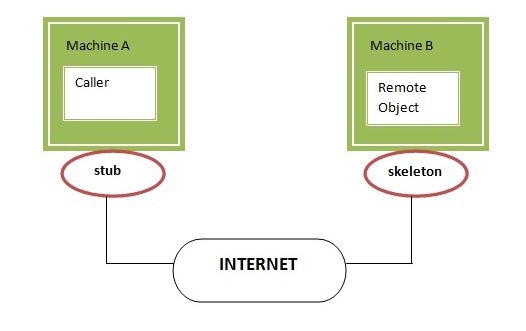2Answer
The RMI (Remote Method Invocation) is an API that provides a mechanism to create distributed application in java. The RMI allows an object to invoke methods on an object running in another JVM.
The RMI provides remote communication between the applications using two objects stub and skeleton.
Understanding stub and skeleton
RMI uses stub and skeleton object for communication with the remote object.
A remote object is an object whose method can be invoked from another JVM. Let's understand the stub and skeleton objects:
stub
The stub is an object, acts as a gateway for the client side. All the outgoing requests are routed through it. It resides at the client side and represents the remote object. When the caller invokes method on the stub object, it does the following tasks:
- It initiates a connection with remote Virtual Machine (JVM),
- It writes and transmits (marshals) the parameters to the remote Virtual Machine (JVM),
- It waits for the result
- It reads (unmarshals) the return value or exception, and
- It finally, returns the value to the caller.
skeleton
The skeleton is an object, acts as a gateway for the server side object. All the incoming requests are routed through it. When the skeleton receives the incoming request, it does the following tasks:
- It reads the parameter for the remote method
- It invokes the method on the actual remote object, and
- It writes and transmits (marshals) the result to the caller.
In the Java 2 SDK, an stub protocol was introduced that eliminates the need for skeletons.

- answered 9 years ago
- Sunny Solu
RMI (Remote Method Invocation) is a way that a programmer, using the Java programming language and development environment, can write object-oriented programming in which objects on different computers can interact in a distributed network. RMI is the Java version of what is generally known as a remote procedure call (RPC), but with the ability to pass one or more objects along with the request. The object can include information that will change the service that is performed in the remote computer. Sun Microsystems, the inventors of Java, calls this "moving behavior." For example, when a user at a remote computer fills out an expense account, the Java program interacting with the user could communicate, using RMI, with a Java program in another computer that always had the latest policy about expense reporting. In reply, that program would send back an object and associated method information that would enable the remote computer program to screen the user's expense account data in a way that was consistent with the latest policy. The user and the company both would save time by catching mistakes early. Whenever the company policy changed, it would require a change to a program in only one computer.
- answered 9 years ago
- Sunny Solu




Your Answer